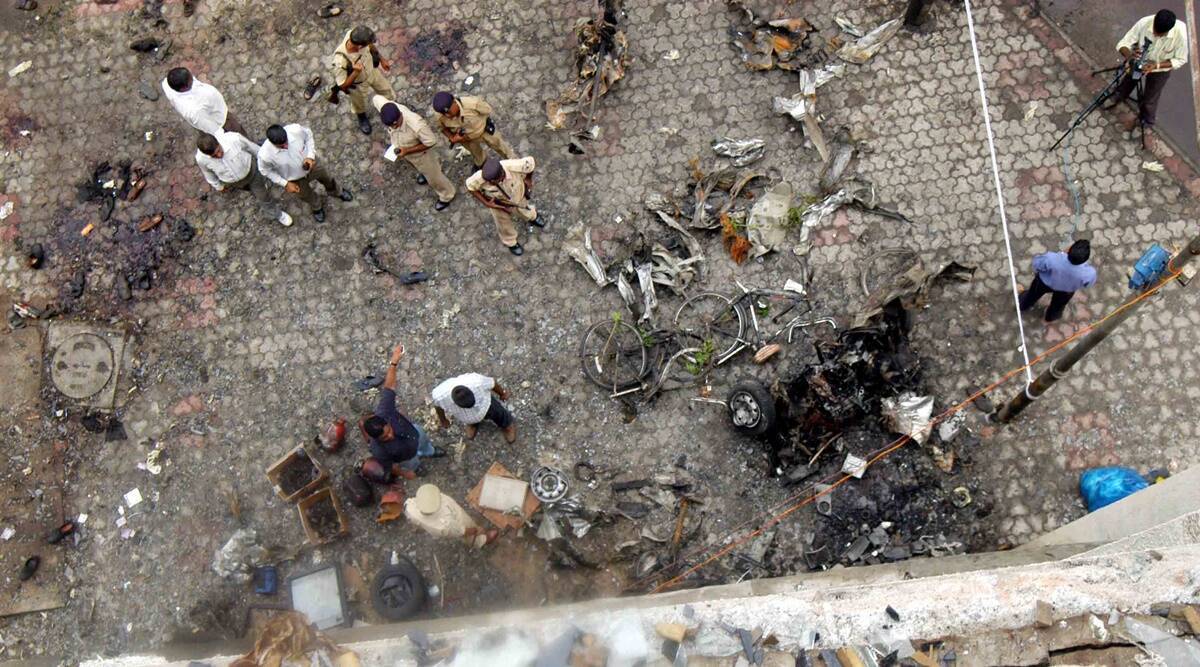 Police investigate the bomb-blast at Civil Hospital in Ahmedabad in 2008. (Express Archive Photo)
Police investigate the bomb-blast at Civil Hospital in Ahmedabad in 2008. (Express Archive Photo) The recent verdict by a special court in the 2008 Ahmedabad bomb blasts case has brought back memories of the dark era, not too long ago, when Indians were routinely killed with wanton disdain.
Consider this data from the South Asia Terrorism Portal (SATP) for regions outside of Jammu and Kashmir, Punjab and the Northeast. In just four years between 2005-08, 663 Indians were killed in terror attacks; since 2014 till now, just four and since 2016, zero.
This is not an incidental statistic. It is a reflection of what prevailing political ideologies can do to a country. Consider the contrast between 2004-14 national mindset of the Congress and 2012-17 mindset of the Samajwadi Party in Uttar Pradesh with what the Narendra Modi government has displayed since 2014.
One of the first acts of the UPA government that came to power in 2004 was to repeal the Prevention of Terrorism Act. The message that went to the terrorists was unmistakable — we now have open season in India. Train commuters in Mumbai and shoppers in Delhi, devotees in Kashi and students in Bengaluru — everyone was a target, no one was safe. Such was the “freedom” that the terrorists enjoyed that they openly bragged about their impending attack through emails sent in advance.
The year 2008 was particularly gruesome. Three hundred and eight Indians were murdered by terrorists that year. That same year, the Indian Mujahideen (IM) attacked cities like Jaipur and Bengaluru while the UPA government contented itself with doing “kadi ninda” for public consumption.
On July 26, 2008, the IM targeted Ahmedabad. Modi was then chief minister of Gujarat. He had police powers only in his state, nowhere else. But when the IM targeted Gujarat, they wrote their death sentence. It was the leads provided by the Gujarat police investigation that eventually led to the Batla House encounter, the liquidation of dreaded terrorists and the arrest of many more. The Indian Mujahideen has not been heard of since. Some of those arrested were among the 49 convicted by the Ahmedabad special court and awarded the death sentence.
But we all know of how the Congress behaved after the encounter. As per Salman Khurshid, the then Congress president became emotional when she saw photos of the encounter. Congress stalwart Digvijay Singh has still not given up his insistence of defaming the Delhi police, even though they lost a brave soldier of India in that encounter.
Cut to 2013. Akhilesh Yadav had become the chief minister of Uttar Pradesh. Among his first acts was seeking to withdraw cases against terrorists who were later convicted. The court thwarted Akhilesh Yadav’s attempt to free Tariq Qasmi, accused of the Gorakhpur blasts of 2007, and instead, tried and convicted him, imposing 20 years of rigorous imprisonment. Imtiaz Ali and Sitara Begum of Kanpur were similarly found guilty and sentenced to jail terms despite the Samajwadi Party seeking to have cases against them withdrawn. During this phase, as many as 14 cases against terrorists were similarly sought to be withdrawn by the Akhilesh Yadav government. It is the courts that thwarted these designs.
It is, first and foremost, the duty of a government to protect its citizens against all enemies — foreign and domestic. Everything else comes later. The experience and commitment that PM Modi brought with him from his Gujarat days manifested itself at the national level after 2014 when he became the prime minister.
On the domestic front, anti-terror laws like Unlawful Activities (Prevention) Act have been strengthened, NIA has been given more teeth, the investigating agencies have been modernised with more resources being made available to them and terror financing has been squeezed through the creation of the Terror Funding and Fake Currency Cell in the NIA. Insurgencies in the Northeast were ended with the signing of historic accords. Incidents of Naxalism have reduced by 70 per cent in 2020 as compared to 2009. Fatalities (civilians and security forces) have reduced by 80 per cent in 2020 as compared to 2010.
On the external front, the armed forces were given a free hand to deal with Pakistan through strikes which, for the first time, imposed a direct cost on that country. Terrorism and terror financing was consistently brought onto the agenda of the G20 through PM Modi’s interventions, eventually leading to a broad international consensus in dealing with terror finance. Pakistan has been on the FATF grey list since 2018, with the threat of blacklisting looming over it.
Today, if India has emerged as a nation that has attracted $80 billion in FDI even during the pandemic, created 42 unicorns in just one year and is the fastest-growing major economy in the world post the pandemic, then the bedrock of this success is the safety and security that has become the new norm under the Modi government. Any threat to the nation is treated as a threat to every Indian.
The writer is CEO, Bluekraft Digital Foundation and was earlier director (content) MyGov.
- The Indian Express website has been rated GREEN for its credibility and trustworthiness by Newsguard, a global service that rates news sources for their journalistic standards.

